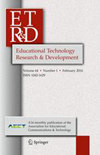
Educational Technology Research and Development is the only scholarly journal in the field focusing entirely on research and development in educational technology.The Research Section assigns highest priority in reviewing manuscripts to rigorous original quantitative, qualitative, or mixed methods studies on topics relating to applications of technology or instructional design in educational settings. Such contexts include K-12, higher education, and adult learning (e.g., in corporate training settings). Analytical papers that evaluate important research issues related to educational technology research and reviews of the literature on similar topics are also published. This section features well-documented articles on the practical aspects of research as well as applied theory in educational practice and provides a comprehensive source of current research information in instructional technology.The Development Section publishes research on planning, implementation, evaluation and management of a variety of instructional technologies and learning environments. Empirically based formative evaluations and theoretically based instructional design research papers are welcome, as are papers that report outcomes of innovative approaches in applying technology to instructional development. Papers for the Development section may involve a variety of research methods and should focus on one aspect of the instructional development process or more; when relevant and possible, papers should discuss the implications of instructional design decisions and provide evidence linking outcomes to those decisions. The Cultural and Regional Perspectives Section (formerly International Review) welcome s innovative research about how technologies are being used to enhance learning, instruction, and performance specific to a culture or region. Educational technology studies submitted to this section should be situated in cultural contexts that critically examine issues and ideologies prevalent in the culture or region or by individuals or groups in the culture or region. Theoretical perspectives can be broadly based and inclusive of research, such as critical race theory, cultural-historical activity theory, and cultural models. Papers published in this section include quantitative, qualitative, and mixed-methods articles and reviews drawing on relevant theories, empirical evidence, and critical analyses of the findings, implications, and conclusions within a cultural context.Educational Technology Research and Development publishes special issues on timely topics of interest to the community, in addition to regular papers.?
《Etr&d-educational Technology Research And Development》是一本由Springer Nature出版商出版的專業(yè)教育學(xué)期刊,該刊創(chuàng)刊于1989年,刊期6 issues per year,該刊已被國際權(quán)威數(shù)據(jù)庫SCIE、SSCI收錄。在中科院最新升級版分區(qū)表中,該刊分區(qū)信息為大類學(xué)科:教育學(xué)3區(qū),小類學(xué)科:教育學(xué)和教育研究 3區(qū);在JCR(Journal Citation Reports)分區(qū)等級為Q1。該刊發(fā)文范圍涵蓋EDUCATION & EDUCATIONAL RESEARCH等領(lǐng)域,旨在及時、準(zhǔn)確、全面地報道國內(nèi)外EDUCATION & EDUCATIONAL RESEARCH工作者在該領(lǐng)域取得的最新研究成果、工作進(jìn)展及學(xué)術(shù)動態(tài)、技術(shù)革新等,促進(jìn)學(xué)術(shù)交流,鼓勵學(xué)術(shù)創(chuàng)新。2023年影響因子為3.3,平均審稿速度 。
中科院分區(qū)(當(dāng)前數(shù)據(jù)版本:2023年12月升級版)
| 大類學(xué)科 | 分區(qū) | 小類學(xué)科 | 分區(qū) | Top期刊 | 綜述期刊 |
| 教育學(xué) | 3區(qū) | EDUCATION & EDUCATIONAL RESEARCH 教育學(xué)和教育研究 | 3區(qū) | 否 | 否 |
中科院分區(qū)(當(dāng)前數(shù)據(jù)版本:2022年12月升級版)
| 大類學(xué)科 | 分區(qū) | 小類學(xué)科 | 分區(qū) | Top期刊 | 綜述期刊 |
| 教育學(xué) | 3區(qū) | EDUCATION & EDUCATIONAL RESEARCH 教育學(xué)和教育研究 | 3區(qū) | 否 | 否 |
中科院分區(qū)(當(dāng)前數(shù)據(jù)版本:2021年12月舊的升級版)
| 大類學(xué)科 | 分區(qū) | 小類學(xué)科 | 分區(qū) | Top期刊 | 綜述期刊 |
| 教育學(xué) | 3區(qū) | EDUCATION & EDUCATIONAL RESEARCH 教育學(xué)和教育研究 | 3區(qū) | 否 | 否 |
中科院分區(qū)(當(dāng)前數(shù)據(jù)版本:2021年12月升級版)
| 大類學(xué)科 | 分區(qū) | 小類學(xué)科 | 分區(qū) | Top期刊 | 綜述期刊 |
| 教育學(xué) | 3區(qū) | EDUCATION & EDUCATIONAL RESEARCH 教育學(xué)和教育研究 | 3區(qū) | 否 | 否 |
中科院分區(qū)(當(dāng)前數(shù)據(jù)版本:2020年12月舊的升級版)
| 大類學(xué)科 | 分區(qū) | 小類學(xué)科 | 分區(qū) | Top期刊 | 綜述期刊 |
| 教育學(xué) | 3區(qū) | EDUCATION & EDUCATIONAL RESEARCH 教育學(xué)和教育研究 | 3區(qū) | 否 | 否 |
名詞釋義:中科院分區(qū)是中國科學(xué)院國家科學(xué)圖書館制定,中科院分區(qū)目前分為基礎(chǔ)版和升級版(試行),基礎(chǔ)版先將JCR中所有期刊分為13大類學(xué)科,每個學(xué)科分類按照期刊的3年平均影響因子高低,分為4四個區(qū);升級版將期刊分為18個大類學(xué)科,涵蓋數(shù)學(xué)、物理與天體物理、化學(xué)、材料科學(xué)、地球科學(xué)等大類學(xué)科;升級版設(shè)計(jì)了“期刊超越指數(shù)”取代影響因子指標(biāo)。期刊超越指數(shù)即本刊論文的被引頻次高于相同主題、相同文獻(xiàn)類型的其它期刊的概率。
JCR分區(qū)(當(dāng)前數(shù)據(jù)版本:2023-2024年最新版)
| 按JIF指標(biāo)學(xué)科分區(qū) | 收錄子集 | 分區(qū) | 排名 | 百分位 |
| 學(xué)科:EDUCATION & EDUCATIONAL RESEARCH | SSCI | Q1 | 64 / 756 |
91.6% |
| 按JCI指標(biāo)學(xué)科分區(qū) | 收錄子集 | 分區(qū) | 排名 | 百分位 |
| 學(xué)科:EDUCATION & EDUCATIONAL RESEARCH | SSCI | Q1 | 53 / 756 |
93.06% |
名詞釋義:JCR(Journal Citation Reports)由科睿唯安公司(前身為湯森路透)開發(fā),JCR分區(qū)將期刊分為176個學(xué)科。該排名根據(jù)當(dāng)年不同學(xué)科的影響因子,分為Q1、Q2、Q3、Q4四個區(qū)域。 Q1代表不同學(xué)科進(jìn)行分類可以影響細(xì)胞因子前25%的期刊,以此作為類推,Q2是前25%-50%的期刊,Q3是前50%-75%的期刊,Q4是后期75%的期刊。
Cite Score 排名
| CiteScore | SJR | SNIP | 學(xué)科類別 | 分區(qū) | 排名 | 百分位 |
| 10.7 | 1.706 | 2.309 | 大類:Social Sciences 小類:Education | Q1 | 41 / 1543 |
97% |
名詞釋義:CiteScore 是在 Scopus 中衡量期刊影響力的另一個指標(biāo),其作用是測量期刊的篇均影響力。當(dāng)年CiteScore 的計(jì)算依據(jù)是期刊最近4年 (含計(jì)算年度) 的被引次數(shù)除以該期刊近四年發(fā)表的文獻(xiàn)數(shù),文獻(xiàn)類型包括:文章、評論、會議論文、書籍章節(jié)和數(shù)據(jù)論文,社論勘誤表、信件、說明和簡短調(diào)查等非同行評議的文獻(xiàn)類型均不包含在內(nèi)。
1、Etr&d-educational Technology Research And Development期刊該細(xì)分領(lǐng)域中屬于中等級別的SCI期刊,在國際上比較受認(rèn)可,過審相對不是特別難, 值得關(guān)注的一本刊物。研究方向?yàn)镋DUCATION & EDUCATIONAL RESEARCH,建議您投遞與此行業(yè)相關(guān)的稿件,以兔被拒稿耽誤您的時間。建議稿件控制10頁以上,4600單詞字?jǐn)?shù)以上(未翻譯中文字?jǐn)?shù)8600字?jǐn)?shù)以上);文章撰寫語言為英語;(單欄格式,單倍行距,內(nèi)容10號字體,文章內(nèi)容包含:題目,所有作者姓名、最高學(xué)位,作者單位(精確到部門),通信作者郵箱,摘要,關(guān)鍵詞,內(nèi)容,總結(jié),項(xiàng)目基金,參考文獻(xiàn),所有作者相片+簡介)。
2、該期刊近年沒有被列入國際期刊預(yù)警名單(2021年12月發(fā)布的2021版),廣大學(xué)者可以放心選擇。鼓勵提交以前未發(fā)表的文章,禁止一稿多投;拒絕抄襲、機(jī)械性的稿件;平均審稿速度 。
3、稿件重復(fù)率控制10%以內(nèi),論文務(wù)必保證原創(chuàng)性、圖標(biāo)、公式、引文等要素齊備,已發(fā)表或引用過度的文章將不會被出版和檢索。
4、稿件必須有較好的英語表達(dá)水平,有圖,有表,有公式,有數(shù)據(jù)或設(shè)計(jì),有算法(方案,模型),實(shí)驗(yàn),仿真等。
5、參考文獻(xiàn)控制25條以上,參考文獻(xiàn)引用一半以上控制在近5年以內(nèi);圖表分辨率必須達(dá)到300dpi;參考文獻(xiàn)與文獻(xiàn)綜述能反映國際研究前沿。
6、若您想聯(lián)系Etr&d-educational Technology Research And Development出版商,請根據(jù)該地址聯(lián)系:ETR&D-Educ. Tech. Res. Dev.。
7、如果你想快速在SCI期刊發(fā)表,可以咨詢本站的客服老師,我們將為你提供SCI期刊全過程管理服務(wù),不成功不收取任何費(fèi)用。
| 影響因子 | h-index | Gold OA文章占比 | 研究類文章占比 | OA開放訪問 | 平均審稿速度 |
| 3.3 | -- | 16.75% | 97.86% | 未開放 |
IF值(影響因子)趨勢圖
中科院JCR分區(qū)趨勢圖
引文指標(biāo)和發(fā)文量趨勢圖
自引數(shù)據(jù)趨勢圖
名詞釋義:影響因子 簡稱IF,是湯森路透(Thomson Reuters)出品的期刊引證報告(Journal Citation Reports,JCR)中的一項(xiàng)數(shù)據(jù)。 即某期刊前兩年發(fā)表的論文在該報告年份(JCR year)中被引用總次數(shù)除以該期刊在這兩年內(nèi)發(fā)表的論文總數(shù)。這是一個國際上通行的期刊評價指標(biāo),是衡量學(xué)術(shù)期刊影響力的一個重要指標(biāo)。
| 中科院同小類學(xué)科熱門期刊 | 影響因子 | 中科院分區(qū) | 瀏覽次數(shù) |
| Computers & Education | 8.9 | 1區(qū) | 971 |
| Asia Pacific Journal Of Education | 1.6 | 4區(qū) | 805 |
| Advances In Health Sciences Education | 3 | 2區(qū) | 600 |
| Medical Education | 4.9 | 1區(qū) | 555 |
| Physics Teacher | 0.5 | 4區(qū) | 477 |
| Education And Information Technologies | 4.8 | 2區(qū) | 444 |
| Medical Teacher | 3.3 | 2區(qū) | 407 |
| Sociology Of Sport Journal | 2 | 3區(qū) | 402 |
| Science & Education | 2.1 | 3區(qū) | 345 |
| Asia-pacific Education Researcher | 3.6 | 3區(qū) | 336 |
若用戶需要出版服務(wù),請聯(lián)系出版商:ETR&D-Educ. Tech. Res. Dev.。